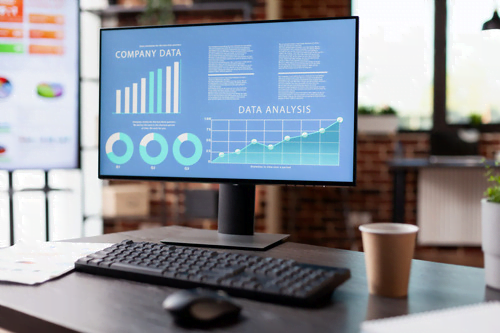
INTRODUCTION
Analysts can discover insights, conclude, and aid in decision-making by examining, cleaning, transforming, and modeling data. This field constitutes a broad and multifaceted field that encompasses a wide range of techniques known by many different names and is used in many different areas of business, science, and the social sciences.
Data analysis is increasingly important for business’s businesses as they seek to make decisions based on empirical evidence. In contrast to data mining, which focuses on statistical modeling and knowledge discovery for predictive rather than merely descriptive purposes, corporate intelligence encompasses such an analysis that relies heavily on aggregation while primarily focusing on business information.
Today, more than ever, businesses are using internal and external data to inform strategic planning, business, and problem-solving. The ability to collect and manipulate large amounts of data in new ways is made possible by business intelligence and big data tools. These insights can help businesses quickly respond to changing market conditions and new opportunities.
OVERVIEW OF THE ARTICLE
What we mean by “data-driven decision-making” is the practice of using your company’s KPIs to collect and analyze data to conclusions. This strategy is fundamental to any viable business plan of the present day. In this article, we’ll discuss the benefits of data-driven decision-making and offer suggestions for incorporating it into your daily operations at work.
When faced with a challenging choice at work, it can be hard to know what to do. Having faith in your decisions may increase if you listen to your gut, but will your team benefit? Achieving success in business hinges on making educated decisions, and doing so requires access to reliable information.
Reasons like competitive advantage and bottom-line growth are elevating data-driven decision-making to a higher priority in today’s business strategy. The benefits of data-driven decision-making are outlined, and suggestions are provided for introducing such approaches in the business world.

EXPLANATION OF DATA ANALYTICS
Data analytics is a method that uses computational methods to gain an understanding of raw data. To draw conclusions and identify patterns, these systems must first transform, organize, and model the data.
The term “data analytics” is often used to refer to the analysis of large volumes of data and/or high-velocity data, which pose unique computational and data-handling challenges, but there are simpler applications in the field as well. Professional data analysts have extensive education and training to enable them to sift through massive datasets in search of meaningful patterns.
Spending on data analytics has been shown to improve revenue, efficiency, marketing, and customer service. In addition, analytics allows companies to respond quickly to emerging market trends, giving them a business over competitors. However, the ultimate goal of data analytics is to boost a company’s bottom line. Depending on the use case, analysis data could be comprised of preexisting records or newly processed data for real-time analysis. In addition, it can come from any number of internal or external data sources.
Data analytics (DA) is a method used to extract meaningful insights and discover recurring patterns from massive datasets. Data analytics increasingly rely on high-end hardware and software tools. To make more educated business decisions, data analytics tools and methods are widely used in the commercial sector.
Business intelligence (BI) and reporting are two of the most elementary forms of data analytics, but the term “data analytics” is often used to refer to a much broader set of methods, including OLAP and other forms of advanced analytics. Because of this similarity, it can be compared to business analytics, another catch-all term for techniques of data analysis. The latter is more general and is used in the business world, while data analytics is more theoretical. This inclusive definition is not shared by all, however. Advanced forms of analytics, which set BI apart, are sometimes referred to as “data analytics.”

IMPORTANCE OF DATA ANALYTICS IN BUSINESS DECISION-MAKING
Many reasons using data to make decisions is a pursuit every modern business should place at the heart of their culture – and we’re going to explore the main points of importance.
Continual organizational growth
The value of data in decision-making is based on its consistency and continuous improvement. Insights across a company’s many functions, processes, and departments can be pinpointed with the help of data. Making consistent, well-considered decisions that lead to measurable benchmarks of improvement and expansion is the key to long-term success in today’s cutthroat digital age.
Knowledge & innovation
The value of data in decision-making is based on its consistency and continuous improvement. Insights across a company’s many functions, processes, and departments can be pinpointed with the help of data. Making consistent, well-considered decisions that lead to measurable benchmarks of improvement and expansion is the key to long-term success in today’s cutthroat digital age. The value of data in decision-making is based on its consistency and continuous improvement. Insights across a company’s many functions, processes, and departments can be pinpointed with the help of data. Making consistent, well-considered decisions that lead to measurable benchmarks of improvement and expansion is the key to long-term success in today’s cutthroat digital age.
New business opportunities
Data-driven decision-making can lead to the discovery of novel and exciting business opportunities. By analyzing easily accessible visual data, business leaders can get a bird’s-eye view of their company’s inner workings and make a series of educated decisions that will promote the company’s expansion and success. With your sharpened discernment, you’ll be able to identify opportunities for personal growth, professional networking, and the development of game-changing ideas that will set you apart from the pack.
Better communication
The more you approach your work with a mindset of data-driven decision management, the more effective a leader you will become, and the more your team will benefit from your guidance. In any insight-driven initiative, whether it be data-driven finance, a data-driven sales strategy, or something else entirely, working with effective KPIs and visualizations will enhance communication throughout.

ANALYTICS IN BUSINESS DECISION-MAKING
Definition of Data-Driven Decision Making
Data-driven decision-making (DDDM) refers to the practice of making important business decisions in light of empirical evidence, such as numerical data, metrics, and other quantifiable information, to better achieve one’s stated goals, objectives, and other initiatives.
When a company recognizes the business of its data, it empowers employees across all departments to make better decisions. But you can’t just pick the right analytics technology and move on to the next strategic opportunity.
Your company needs to make data-driven decision-making the norm to create an atmosphere where questioning assumptions and digging deeper into problems is valued. Data is the focal point of conversations at all levels, and participants hone their data literacy through practice.
Fundamentally, this requires a self-service model that provides quick and simple entry to pertinent data while still being subject to adequate security and management. Furthermore, it requires expertise, which can be used to create data-savvy employee training and development programs. Finally, getting executive support and building a community that embraces data-driven decision-making will inspire others to follow suit.
Advantages of Data-Driven Decision Making
With access to employee data, HR and other company leaders can better analyze trends and anticipate the needs of the business. So, how about the supervisors on your front lines? Evidence-based choices outperform guesses every time. It would be foolish to dismiss the potential growth-fueling effects of a proactive and predictive people analytics function.
Some of these advantages are discussed below
Increased accountability
Which members of your team have made the greatest contributions? Which teams have a goal deficit that they need to close? When decisions are grounded in evidence, responsibility is increased. When “everyone can see how their individual decisions connect to a strategy, it helps change the way organizations think about accountability in DEI, revenue, and changes in the workforce,” you’ve connected with the larger enterprise goals.
The reorganization of data ownership is often necessary for this amicable resolution. By having access to the same data, managers at all levels can identify which teams are succeeding and which need assistance before problems escalate.
Better efficiency
Could you drive if you couldn’t see what you were doing? Or, lead a group without knowing which roles will be vacant in the coming year. Rapid development is possible when all group leaders have access to the necessary information. According to the latest findings of the High Impact People Analytics report, high-performing organizations put people analytics tools in the hands of leaders, managers, and employees at all levels.
It is difficult for a company to differentiate itself based on product and service alone, so having the right people with the right skills and capabilities to do the work and a process to get the information your workforce needs to do that work and achieve desired outcomes is crucial for any organization. People analytics solutions will bring bite-sized, just-in-time insights for individuals and teams, says Chris, going “beyond leadership and into the everyday work lives of employees.”
Alignment on company-wide goals
When information is shared amongst a large group of people, it becomes more than just a single piece of data. It can serve as a guide in the sky, like the North Star. He thinks the sky is the limit when managers can see everything about their employees. Smaller actions and decisions can be linked to a larger strategy and an even larger outcome when everyone is using the same data.
Everyone should know their place in the company and if they are being paid fairly according to their demographics if the goal of your business is to increase diversity, equity, and inclusion.

A sense of ownership at every level
We can increase trust in the data, promote transparency and accountability, and unite the company around a common set of metrics if managers at all levels have access to people analytics.
Instead of keeping spreadsheets on secret servers or keeping HR data isolated behind firewalls, high-performing teams will be able to communicate with lower-performing teams about when they have best practices to share and when they need to step it up.
Transparency
When a company operates openly and transparently and encourages its employees, customers, and investors to share information freely, a trusting business is formed. A vital indicator of the organization’s overall health is the information we can glean from looking into its people. You wouldn’t leave anything out when discussing your financial situation. You wouldn’t keep useful information to yourself if you had any.
To that end, “don’t hold back on anything” he says, “when it comes to the information of your people. The size of your company is based on the number of employees you have, right? Have you hired enough people to fill the most crucial roles? The average tenure at a company is how long? As an employee, why do you feel you have to resign?

CHALLENGES IN IMPLEMENTING DATA-DRIVEN DECISION-MAKING
Using evidence to make choices is easier in theory than in practice. Leaning on your data to make better decisions isn’t without its challenges. Failure to foresee and prepare for potential obstacles can impair your ability to make sound data-driven decisions. Bad choices made under these conditions can hurt your advertising and sales activities.
To keep your data-driven decision-making operations running smoothly, we’ve compiled some of the most common challenges you’ll face. Problems with instituting a system for making choices that rely heavily on data.
A Lack Of Infrastructure And Tools
The data is difficult to acquire because you need the right infrastructure and tools to collect it. Many businesses use a CRM to collect and organize data about their customers in a centralized database. Your data analysis and visualization tools should complement your data collection and management solution.
Poor Quality Data
A significant difficulty in data collection is ensuring that your data is of high quality. Issues with duplicates, inaccuracies, inconsistencies, and incompleteness are just a few examples of how your data quality could be affected. Moreover, the consequences of using inaccurate or out-of-date information are severe. Incomplete, inaccurate, or irrelevant information frequently leads to subpar decision-making.
Siloed Data
Siloed data occurs when different data sources aren’t properly integrated. For example, if your marketing team’s data isn’t combined with your sales team’s data. This can compromise the quality of your data. For example- your marketing team may be missing valuable data on a customer that your sales team has, thereby limiting their ability to make more informed decisions. Ensuring that there are no data silos will help ensure that everyone in your organization has access to the same data.
A Lack Of Organization-Wide Buy-In
Make sure that everyone across your organization buys into data-driven decision-making, especially when it comes to key players. When certain individuals or teams don’t buy in, they may not enter the data that you need to analyze the full scenario. As such, making sure that everyone is on the same page is vital to the effectiveness of your ability to collect and analyze accurate data.
Not Knowing How To Use Your Data
Even if you’re collecting data that is accurate, another issue that might come up is knowing how to leverage your data to help make key decisions. Not knowing what to do with the data you have or what actions you need to take based on your analytics defeats the purpose of data-driven decision-making.
UNDERSTANDING DATA ANALYTICS
The best approach to data analytics for any given organization will depend on its current developmental status. While analytics have found widespread business, they typically only provide information that can be used to make decisions after the fact rather than to foresee and prevent issues before they even arise.
An increasing number of businesses are adopting high-end data analytics solutions that make use of machine learning to enhance business decisions and spot trends and opportunities in the market. A company’s performance may suffer if it waits too long to implement data analytics with proactive, future-casting capabilities, which could lead to a business of previously unnoticed patterns and insights.
Types of Data Analytics
Descriptive Analytics
Descriptive analytics should serve as the bedrock of any reporting system; without it, business intelligence (BI) tools and dashboards would be useless. Questions like “how many?” “When?” “Where?” and “what?” are all satisfactorily addressed. Descriptive analytics can also be categorized using ad hoc reporting and pre-made reports.
A pre-written report contains information that has been organized and tailored for a particular purpose. For instance, you may receive a monthly report from your advertising agency or in-house advertising team detailing the metrics of your most recent advertising campaigns’ success.
Ad hoc reports, on the other hand, are made up as needed and rarely adhere to a strict schedule. Whenever there is a need to resolve a pressing issue or answer a pressing question in the business world, these documents are drafted. When you need to drill down into the finer details of your search, a report like this will come in handy.
A special report could be compiled on the demographics and interests of the people who have liked your company’s social media profile, in comparison to similar pages in your industry.
The accuracy of this tool greatly enhances your capacity to analyze your social media following. You shouldn’t need to revisit this report type unless there’s a drastic change in your intended audience.
Predictive Analytics
Predictive analytics may see the most use among all of the subfields of data science. Predictive analytics is used by businesses to spot patterns, connections, and causes. This broad class can be further subdivided into predictive modeling and statistical modeling, but it’s important to remember that these two approaches complement one another.
Predictive analytics could be used in a Facebook ad campaign for t-shirts, for instance, to ascertain the degree to which the campaign’s conversion rate tracks with demographic information such as location, income, and consumer interests. After collecting data from two (or more) distinct demographics, predictive modeling could estimate how much money could be made from selling to each group.
Prescriptive Analytics
Prescriptive analytics is a subfield of corporate analytics that makes use of AI and big data to prescribe actions in response to forecasts. Analyses of this type include optimization and random testing.
Advanced machine learning techniques are put to use in prescriptive analytics to answer questions like “What if we try this?” and “What is the best action?” You’ll know which variables to try, and you might even be able to suggest some more that will boost the odds of success even further.

ROLE OF DATA ANALYSIS IN DECISION-MAKING
Extracting metrics and key performance indicators (KPIs) from data is not always a simple process. It can be challenging to obtain timely integrated data when information is dispersed across the company. Collecting the information and conducting the analysis your business requires can be a sluggish and tiresome process.
This is probably due to a lack of available analytical resources. Information is available, but there is no mechanism for instantaneous retrieval. Data or business analysts should be able to independently and rapidly visualize and analyze data. The data is often scattered, necessitating manual collection by staff before analysis can begin.
Due to the prevalence of various sales applications, businesses may have access to marketing or financial data extracts in CSV or Excel format, for instance. They may also include ad hoc data collection in some cases. Before meaningful metrics or analyses can be derived, the data must first be combined, perhaps by treating a spreadsheet as if it were a database
The data collection process takes significantly longer than the analysis phase. In three weeks, a new analysis may be necessary, but it’s unrealistic to expect anyone to repeat this arduous and time-consuming process.
Inconsistencies in the data can also be introduced by employing this technique. It is common practice for workers to use a collaborative spreadsheet that is regularly updated. Inaccuracies have crept into the data due to the lack of a centralized, up-to-date source and the widespread use of outdated versions of the original spreadsheet by various groups.
The problem is made worse when spreadsheets are shared because of the inevitable formula errors and broken links. The problems inherent in using a spreadsheet as a database are exacerbated by the fact that spreadsheets have their unique quirks.

CUSTOMER DATA ANALYTICS
Customer analytics, also known as customer data analysis, is the study of a company’s customer base to gain insight into its clientele and improve services. An analytical methodology and framework, as well as data collection and organization tools, are crucial to any customer analytics effort. Businesses use analytics to help them make choices in areas such as product creation, business, and sales.
A common business decision that can be informed by customer analytics is choosing the advertising platform with the highest return on investment. Mapping the entire customer journey and adapting marketing strategies to that journey are examples of complex business decisions.
Using customer analytics has perks beyond just informing astute advertising choices. Moreover, they may have a major impact on your financial stability.
Importance of These Analytics
The value of analyzing consumer data continues to rise. Why this matters, and what you should be considering if you’re curious: The modern consumer enjoys unprecedented freedom of choice and access to information. And things are only getting worse.
Customers can access data about stores, products, prices, and other relevant information whenever and wherever they want. That’s why it’s so important to track consumer data so you can foresee how they’ll respond to your brand. The more you know about your customers, the easier it will be to cater to their wants and needs and make offers that will interest rather than repel them.
In today’s business world, where customers are more empowered and connected than ever before, customer analytics has taken on greater significance. The more a business learns about its customers’ habits and preferences, the better it can tailor its recommendations to them and attract similar customers.
Increasingly, businesses recognize the value of analyzing customer behavior to determine areas for enhancement. When businesses have access to all relevant information, such as where to shop, what to buy, how to pay, etc., they are better able to interact with customers based on their preferences.
Businesses need reliable data on consumer buying patterns and preferences to design marketable new offerings. Because of the comprehensive nature of 360-degree data analytics, businesses can better target their marketing and sales initiatives to each customer.
Customer happiness is essential to the long-term survival of any online business. Predictive customer analysis helps in creating new approaches to increase customer satisfaction. One of the most important goals of any customer analysis strategy should be to increase customer loyalty.
Good customer analytics will allow you to target the right customers at the right time, drastically reducing your campaign’s overall cost.

UNDERSTANDING CUSTOMER DATA ANALYTICS
By “customer analytics,” or “consumer data analytics,” we mean the systematic study of a company’s customers and their actions to identify, attract, and retain the most profitable customers.
Managers from many different departments, such as marketing, sales, customer service, information technology, and business analysis, are typically involved in customer analytics. The team needs to agree on which business metrics can give a complete picture of the customer experience to get any actionable data.
Customer analytics is built on raw data, which in turn leads to better business decisions. Customer analytics, which ultimately leads to well-informed business decisions, are built on the foundation of raw data. Before decisions can be made based on data, it must undergo three processes: collection, organization, and analysis.
To get started, businesses must compile raw consumer data from a wide range of sources such as marketing automation platforms, CRM systems, and even public records.
Some examples of data that could be gathered are listed below:
demographics
purchase history
web and social media activity
contact center interactions
advertisement engagements
survey responses
One way that businesses can gain insight from their data is with the help of a customer analytics tool. For instance, the program may aggregate data from several sources, including user profiles, purchase histories, and social media engagement.
Benefits of Customer Data Analytics
Good customer analytics can help you learn things like your clientele’s age range, gender, purchasing habits, and satisfaction levels. Both financial statements and customer analytics can provide insight into a business’s viability. Let’s take a look at the most crucial benefits of customer analytics so that you can better understand how to use them to grow your business.
One can accomplish the following with the help of customer analytics:
Increase the efficiency of your marketing strategy
Good customer analytics can help you learn things like your clientele’s age range, gender, purchasing habits, and satisfaction levels. Both financial statements and customer analytics can provide insight into a business’s viability. Let’s take a look at the most crucial benefits of customer analytics so that you can better understand how to use them to grow your business. One can accomplish the following with the help of customer analytics:
Attract and retain more high-value customers
If you know who your most valuable customers are, you can focus your marketing efforts on attracting and retaining them. It’s important to target your marketing and sales efforts toward bringing in and keeping high-value customers who will make repeat purchases. With the help of information about your most valuable customers, you can target your paid advertising and email marketing toward people who are more likely to make a purchase. To get the most out of your advertising budget and hit your sales and marketing goals, you need to narrow your focus.
Improve onboarding to encourage the second purchase
If you know who your most valuable customers are, you can focus your marketing efforts on attracting and retaining them. It’s important to target your marketing and sales efforts toward bringing in and keeping high-value customers who will make repeat purchases.
With the help of information about your most valuable customers, you can target your paid advertising and email marketing toward people who are more likely to make a purchase. To get the most out of your advertising budget and hit your sales and marketing goals, you need to narrow your focus.
Personalize the online shopping experience
Companies can improve the experience they offer their customers across all channels by collecting data from them, especially first-party and zero-party information. Customers will feel more connected to your brand if you collect data from them and immediately apply it to new content and personalized recommendations.
Don’t just rely on the information that is automatically collected during a transaction; think outside the box about how you can best gather information about your customers. Find out their preferences and preferences, wants and needs, priorities, and expectations from a brand.

REAL-LIFE EXAMPLES OF THIS ANALYTICS IN BUSINESS DECISION-MAKING
Now more than ever, information is the driving force behind most modern businesses. As more and more people gain access to the internet, data packets are being sent all over the world. Business owners understand this data could help them better serve their customers, understand market trends, and identify untapped opportunities.
To derive actionable insights from data, it must be analyzed and specific information is drawn that can be used to improve specific aspects of a market or a business. To maintain a competitive edge, businesses are increasingly adopting data analytics tools. For tasks like keeping tabs on crime, data analysis is being used by both private companies and government agencies.
Walmart
The New York Times reported in 2004 that Walmart had used a similar procedure to prepare emergency supplies for Hurricane Frances. Executives from various companies wanted to know what they should stock up on in anticipation of a business. Analysts sifted through a terabyte of customer data from similar situations at other Walmart stores to figure out what supplies to ship to Florida (quantitative data).
It would appear that when disaster strikes, Americans turn to strawberry Pop-Tarts and beer. Trucks carrying toaster pastries and six-packs were reportedly speeding down Interstate 95 toward Walmarts in Frances’ path because of Walmart’s “predict what’s going to happen, instead of waiting for it to happen,” as stated by the retailer’s then-chief information officer, Linda M. Dillon.
Analysts at Walmart were able to anticipate the high demand for storm necessities like beer and Pop-Tarts, and as a result, the company made a profit.
Amazon
Another frequently cited example of data-driven decision-making is Amazon. The online retailer makes informed product recommendations based on customers’ past purchases and other data collected through behavioral analytics.
The user will be presented with these recommendations at various points throughout the shopping process, from product browsing to the checkout page, to make the experience more personalized. Amazon may recommend a phone case to a customer who has recently made a purchase, such as a mobile phone, either at the time of purchase or via email a few days later.
By monitoring its customers’ purchases, Amazon can better meet their needs and boost its profits.
Netflix
The streaming service Netflix has amassed more than 128 million active users and a commanding lead in the market thanks to its use of data for customer retention. The company saw the need to upgrade the customer experience as competition intensified.
Customers’ watch time, date, location, typical content consumed, pause and resume times, and other metrics were analyzed in great detail to reach this conclusion. A trustworthy recommendation algorithm is created using this information to enhance the viewing experience for the viewer.
After the algorithm went live, the business analyzed the data and discovered that nearly 80% of users followed the system’s recommendations. This method has been shown to increase employee loyalty and keep businesses ahead of the competition. It exemplifies the value of data in decision-making.

SUMMARY
A data-driven approach allows for rapid response to market shifts. With this knowledge, companies will be able to make better decisions and better anticipate the results of their business activities. If you want to grow your business, outshine the competition, and earn your customers’ loyalty, you need a solution like this. Time spent analyzing data is well spent if it leads to increased profits for the business.
Some of the talking points have been discussed below.
Future of Data Analytics in Organization Decision-Making
Today’s businesses require enterprise-wide approaches based on data and analytics. The collected data and analytics will be supplemented with critical, intellectual, and creative thought, leading to improved decisions. The ability of leaders to diagnose issues, reach sound conclusions, and make sound business decisions will be enhanced. Business success depends on the business’s ability to make educated choices. Businesses can benefit from taking appropriate risks by making decisions with the aid of data and analytics. Where do we see data and analytics going from here? Okay, then, let’s find out.
Deliberations in the future will be heavily influenced by the insights gleaned from data and analytics. It can help businesses run more efficiently, ask the right questions, collect timely data, and make more informed choices.
Efficient Operations
Today’s businesses require enterprise-wide approaches based on data and analytics. The collected data and analytics will be supplemented with critical, intellectual, and creative thought, leading to improved decisions. The ability of leaders to diagnose issues, reach sound conclusions, and make sound business decisions will be enhanced. Corporate success depends on the business’s ability to make educated choices. Businesses can benefit from taking appropriate risks by making decisions with the aid of data and analytics. Where do we see data and analytics going from here? Okay, then, let’s find out.
Deliberations in the future will be heavily influenced by the insights gleaned from data and analytics. It can help businesses run more efficiently, ask the right questions, collect timely data, and make more informed decisions.
Asking the Right Questions
Through the use of analytics and data, companies can boost business, reduce costs, and streamline processes. However, businesses can use data and analytics to their advantage by expanding the business of their target markets. To avoid wasting resources on advertisements and other content that doesn’t resonate with business audiences, data and analytics can aid in better decision-making.

CONCLUDING REMARKS
Business leaders can better adapt to changes in consumer behavior and opinion with the help of data analysis. To better prepare for challenging scenarios in light of the gloomy economic outlook for 2022, businesses must use data analysis to gain insights into their audiences to strengthen their marketing strategies and decision-making.










